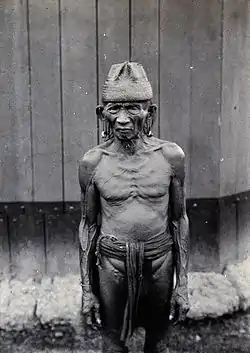Bukitan people
Bukitan (also known as Baketan) is a small tribe living in the state of Sarawak, Malaysia and East Kalimantan of Indonesia. They are found in Bintulu district of Sarawak. Not many of these people are left due to intermarriages with other tribes, adopting Iban people agricultural practices and way of life.[3]
 | |
| Regions with significant populations | |
|---|---|
| Borneo: | |
| 289 (2000)[1] | |
| 570 (2000)[2] | |
| Languages | |
| Bukitan language, Malay language (Sarawakian Malay), Malaysian English | |
| Religion | |
| Christianity (predominantly), Animism | |
| Related ethnic groups | |
| Ukit people, Sian, Kejaman, Sekapan and Lahanan | |
History
The origin of the Bukitan is from Palin, Kalimantan. They moved into Sarawak via Lubok Antu and settled there in the 19th century.[4] Then, in came the Ibans from Kapuas (in Kalimantan), a powerful headhunting tribe at that time, attacking them and chasing them out of their homeland.[5][6]
They fled to Saribas which is what is now in the Betong Division. There, they settled and built their community. During those years, they co-existed with the Ibans, after a peace sealed by the marriage of the daughter of their leader Entinggi to the son of the Iban chief Tindin.[7]
After many years, due to some misunderstandings, war broke out with the Ibans and they lost. They again fled to various places before settling in Sungai Merit, a tributary of Batang Tatau river in Bintulu division and its vicinity until today.[8]
Evidence of Bukitan existence can be found in areas such as the Saribas (Paku, Layar and Rimbas)[9] and Lubok Antu in the form of burial grounds, name of places and ancient orchards.
Notable people
- Jonathan Tinggang Ngabang, a high jumper Malaysian athlete.[10]
References
- Raymond G. Gordon Jr., ed. (2005). Ethnologue: Languages of the World, Fifteenth edition. SIL International. ISBN 1-55671-159-X.
- "Bukitan". Ethnologue. Retrieved 22 June 2019.
- Jean-Francois Bissonnette, Stephane Bernard & Rodolphe De Koninck (2011). Borneo Transformed: Agricultural Expansion on the Southeast Asian Frontier. NUS Press. ISBN 9971-69-544-8.
- Victor T. King (1995). The Maloh of West Kalimantan: an ethnographic study of social inequality and social change among an Indonesian Borneo people. Foris Publications. p. 53. ISBN 90-676-5065-X.
- Traude Gavin (2004). Iban Ritual Textiles. NUS Press. p. 4. ISBN 99-716-9294-5.
- Vinson H. Sutlive & Joanne Sutlive, ed. (2001). The Encyclopaedia of Iban Studies: O-Z. Tun Jugah Foundation. p. 1593. ISBN 98-340-5133-6.
- Barau Anak Gelayan (2016). Nalong Anak Buda (ed.). Betie Tajak Ngakak Tajai Ngelayang. Johnny Anak Chuat. ISBN 967-10174-8-7.
- Vinson H. Sutlive & Joanne Sutlive, ed. (2001). The Encyclopaedia of Iban Studies: A-G. Tun Jugah Foundation. p. 321. ISBN 98-340-5131-X.
- Rob A. Cramb (2007). Land and Longhouse: Agrarian Transformation in the Uplands of Sarawak. NIAS Press. ISBN 87-7694-010-1.
- "Host state treats Sarawak athletes to Gawai gathering". The Borneo Post. 3 June 2014. Retrieved 26 August 2015.